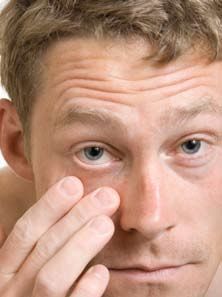OTC Case Studies: Ocular and Skin Disorders


Case 1—Eyelid Nodule
AS, a 28-year-old man, presents to the pharmacy with a “lump on his eyelid” that he first noticed the day before and describes as being tender to the touch. He reports no pain or discharge from the eye, but indicates the nodule is starting to cause some mild irritation. He has not had any recent trauma to the eye. Upon inspection, you notice some localized swelling and redness where the nodule is located (at the base of an eyelash), and that it does not appear to be associated with a loss of lashes or discoloration of the surrounding skin. Identify AS’s condition and describe appropriate self-care strategies to alleviate his symptoms.

Answer: Mild disorders of the eye and eyelid are common reasons patients seek the advice of a pharmacist. AS is most likely suffering from an external hordeolum or stye—an acute inflammation of the eyelid that usually arises from an occluded eyelash follicle or tear gland. For patients with symptoms of serious ocular disorders, referral for evaluation by a physician or ophthalmologist is critical to prevent treatment delays or vision loss; however, AS reports generally mild symptoms. He does not report crusting, scaling, or significant reddening of the eyelid, which could indicate infection. Skin cancer of the eyelid, which can present as discolored nodules and a loss of eyelashes, is also an unlikely cause of his ailment. Styes usually resolve spontaneously, but for bothersome symptoms, patients may be counseled to apply warm compresses to the affected eyelid for 5 to 15 minutes several times per day—using a new compress each time and not using compresses that are too hot to minimize irritation and injury to the delicate eyelid skin. Homeopathic eye drops and ointments may be used for symptomatic relief of redness, discomfort, and irritation; however, there is little evidence to indicate that these products expedite healing or resolution of the stye itself. For symptoms that worsen or persist for more than a week with self-care, physician referral is warranted.
Case 2—Itchy Rash
MG is a 39-year-old woman who comes to the pharmacy complaining of an itchy rash all over her legs. She first noticed the rash after she went hiking through a wooded area 2 days ago. Upon inspection, you notice linear streaking that looks like a mild dermatitis. What is MG’s condition, and how would you treat it?
Answer: MG’s rash is likely poison ivy, based on her history of recent outdoor activity. The goals of selftreatment include protecting the area to prevent itching and excessive scratching, which may lead to open lesions or secondary skin infections. After exposure to the poison ivy plant, the patient should wash the affected area to remove any remaining allergens within 10 minutes of exposure. Although MG is not likely to benefit from washing her skin 2 days after exposure, it is prudent to recommend she wash exposed clothes to prevent the rash from spreading due to indirect contact. Because her rash is mild, it is recommended that MG apply cool compresses of either oatmeal bath or calamine lotion. The addition of menthol (0.25%) and phenol (1%) to the calamine lotion can also be an option to alleviate itching. The American Academy of Dermatology also recommends the use of topical steroids to relieve localized itching or swelling for mild cases of contact dermatitis.1 MG should apply a steroid cream twice daily for 2 weeks or while the rash persists.
Patients experiencing severe symptoms, (eg, having numerous bullae, extreme itching, irritation, or swelling of extremities); a rash covering more than 25% of total body surface area or affecting the face, eyes and eyelids, or genitals; and children younger than 2 years of age are not candidates for self-treatment and should be counseled to seek physician referral.2 â–
Dr. Patel is a clinical pharmacist in North Brunswick, New Jersey, and clinical assistant professor at Ernest Mario School of Pharmacy, Rutgers University. Dr. Bridgeman is an internal medicine clinical pharmacist in Trenton, New Jersey, and clinical assistant professor, Ernest Mario School of Pharmacy.
References
1. Rietschel RL, Adams RM, Daily AD. Guidelines for care of contact dermatitis. J Am Acad Dermatol 1995;32:109-113.
2. Brodell RT, Williams L. Taking the itch out of poison ivy: are you prescribing the right medication? Postgrad Med 1999;106:69-70.

